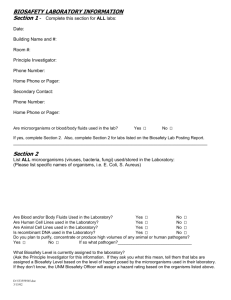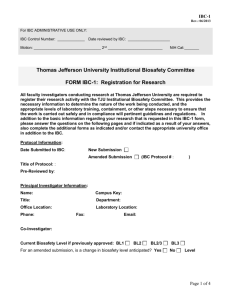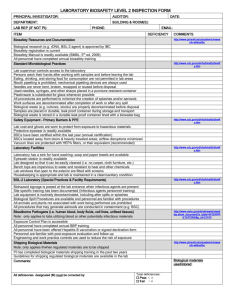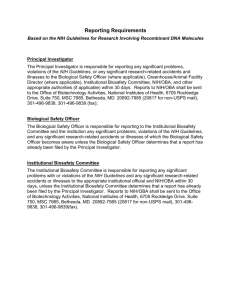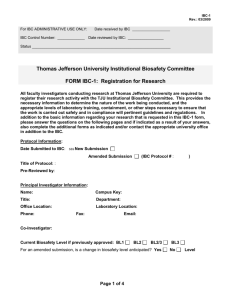MEMORANDUM - Icahn School of Medicine at Mount Sinai
advertisement
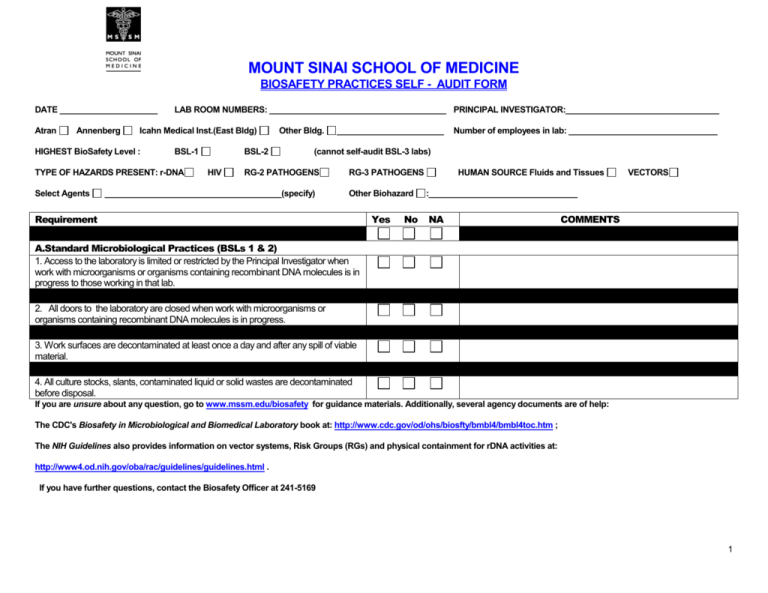
MOUNT SINAI SCHOOL OF MEDICINE BIOSAFETY PRACTICES SELF - AUDIT FORM DATE _____________________ Atran Annenberg LAB ROOM NUMBERS: ______________________________________ PRINCIPAL INVESTIGATOR:_________________________________ Icahn Medical Inst.(East Bldg) HIGHEST BioSafety Level : BSL-1 TYPE OF HAZARDS PRESENT: r-DNA Select Agents BSL-2 HIV Other Bldg. _______________________ Number of employees in lab: ________________________________ (cannot self-audit BSL-3 labs) RG-2 PATHOGENS ______________________________________(specify) RG-3 PATHOGENS Other Biohazard Requirement Yes No HUMAN SOURCE Fluids and Tissues VECTORS :________________________________ NA COMMENTS A.Standard Microbiological Practices (BSLs 1 & 2) 1. Access to the laboratory is limited or restricted by the Principal Investigator when work with microorganisms or organisms containing recombinant DNA molecules is in progress to those working in that lab. 2. All doors to the laboratory are closed when work with microorganisms or organisms containing recombinant DNA molecules is in progress. 3. Work surfaces are decontaminated at least once a day and after any spill of viable material. 4. All culture stocks, slants, contaminated liquid or solid wastes are decontaminated before disposal. If you are unsure about any question, go to www.mssm.edu/biosafety for guidance materials. Additionally, several agency documents are of help: The CDC's Biosafety in Microbiological and Biomedical Laboratory book at: http://www.cdc.gov/od/ohs/biosfty/bmbl4/bmbl4toc.htm ; The NIH Guidelines also provides information on vector systems, Risk Groups (RGs) and physical containment for rDNA activities at: http://www4.od.nih.gov/oba/rac/guidelines/guidelines.html . If you have further questions, contact the Biosafety Officer at 241-5169 1 BIOSAFETY PRACTICES SELF - AUDIT FORM Requirement Yes No NA COMMENTS A. Standard Microbiological Practices (BSLs 1 & 2) continued 5. Mechanical pipetting devices are used; mouth pipetting is prohibited. 6. Eating, drinking, smoking, and applying cosmetics are not permitted in the laboratory work area. 7.Persons wash their hands: (i) after handling materials involving microorganisms or organisms containing recombinant DNA molecules and animals, and (ii) when exiting the laboratory. 8. All procedures are performed carefully to minimize the creation of aerosols. 9 Are all reusable lab glassware and accessories decontaminated after each use? If you are unsure about any question, go to www.mssm.edu/biosafety for guidance materials. The CDC's Biosafety in Microbiological and Biomedical Laboratory book at: http://www.cdc.gov/od/ohs/biosfty/bmbl4/bmbl4toc.htm ; The NIH Guidelines are at: http://www4.od.nih.gov/oba/rac/guidelines/guidelines.html . 2 BIOSAFETY PRACTICES SELF - AUDIT FORM Requirement Yes No NA COMMENTS B. Special Practices (BSLs 1 & 2) 1. Contaminated materials that are to be decontaminated at a site away from the laboratory are placed in a durable leak-proof container which is closed before being removed from the laboratory. 2. The Principal Investigator limits access to the laboratory. The Principal Investigator has the final responsibility for assessing each circumstance and determining who may enter or work in the laboratory. 3. The Principal Investigator establishes policies and procedures whereby only persons who have been advised of the potential hazard and meet any specific entry requirements (e.g., immunization) may enter the laboratory or animal rooms. 4. When the microorganisms or organisms containing recombinant DNA molecules in use in the laboratory require special provisions for entry (e.g., vaccination), a hazard warning sign incorporating the universal biosafety symbol is posted on the access door to the laboratory work area. The hazard warning sign identifies the agent, lists the name and telephone number of the Principal Investigator or other responsible person(s), and indicates the special requirement(s) for entering the laboratory. 5. An approved disinfectant known to be effective against the organisms in use is present in the laboratory 6. Laboratory coats, gowns, smocks, or uniforms are worn while in the laboratory. Before exiting the laboratory for non-laboratory areas (e.g., cafeteria, library, administrative offices), this protective clothing is removed and left in the laboratory or covered with a clean coat not used in the laboratory. 7. Animals not involved in the work being performed are not permitted in the laboratory. 8. Special care is taken to avoid skin contamination with organisms containing recombinant DNA molecules; gloves should be worn when handling experimental animals and when skin contact with the agent is unavoidable. 9. All wastes from laboratories and animal rooms are appropriately decontaminated before disposal. 3 BIOSAFETY PRACTICES SELF - AUDIT FORM Requirement Yes No NA COMMENTS B. Special Practices (BSLs 1 & 2) continued 10. Only needle-locking syringes or disposable syringe-needle units (i.e., needle is integral to the syringe) are used for the injection or aspiration of fluids containing contain biological agents or organisms that contain recombinant DNA molecules. Hypodermic needles and syringes are used only for parenteral injection and aspiration of fluids from laboratory animals and diaphragm bottles. 11. Needles should not be bent, sheared, replaced in the needle sheath or guard, or removed from the syringe following use. Extreme caution should be used when handling needles and syringes to avoid autoinoculation and the generation of aerosols during use and disposal. 12. The needle and syringe should be promptly placed in a puncture-resistant container and decontaminated, preferably autoclaved, before discard to Biosystems container or reuse. 13. Baseline serum samples for laboratory and other at-risk personnel are collected and stored immediately after an incident. Additional serum specimens may be collected periodically depending on the agents handled or the function of the facility and as appropriate. 14. Spills and accidents which result in overt / or suspected exposures to material containing biological agents are immediately reported to the Institutional Biosafety Officer and the Committee; if recombinant DNA molecules are involved,notification is made to the Institutional Biosafety Officer , the IBC, and to NIH/OBA.** 15. A biosafety manual is prepared or adopted. Personnel are advised of special hazards through written SOPs and are required to read and follow instructions on practices and procedures. **Reports to NIH/OBA shall be sent to the Office of Biotechnology Activities, National Institutes of Health, 6705 Rockledge Drive, Suite 750, MSC 7985, Bethesda, MD 20892-7985 (20817 for non-USPS mail), 301-496-9838, 301-496-9839 (fax). All Medical evaluations, surveillance, and treatments are provided as appropriate and written records are maintained as required by OSHA and other agencies. 4 BIOSAFETY PRACTICES SELF - AUDIT FORM Requirement Yes No NA COMMENTS C. Containment Equipment (BSL2) 1. Biological safety cabinets (Class I or II) or other appropriate personal protective or physical containment devices are used whenever procedures with a high potential for creating aerosols are conducted (see Appendix G-III-L and Appendix G-III-O, Footnotes and References of Appendix G-NIH Guidelines). These may include centrifuging, grinding, blending, vigorous shaking or mixing, sonic disruption, opening containers of materials whose internal pressures may be different from ambient pressures, intranasal inoculation of animals, and harvesting infected tissues from animals or eggs. 2. Biological safety cabinets (Class I or II) or other appropriate personal protective or physical containment devices are used whenever high concentrations or large volumes (10L) of microorganisms or organisms containing recombinant DNA molecules are used. (see Appendix G-III-L, Footnotes and References of Appendix G). 3. Are Biological Safety Cabinets in use certified annually?(Required for HIV and Last Date Certified: Certifier: other BBP production labs -document needed-photocopy and attach) 4. All Specimens / Cultures are secured from general access by non-laboratory associated individuals in freezers and / or incubators? (Lock and key access?) 5. Are signs with Biohazard symbols posted on all stock culture containers? 6. Are all biomedical wastes, including gloves and disposable Personal Protection Equipment items, disposed of only in red bags? (Not in clear bags) If you are unsure about any question, go to www.mssm.edu/biosafety for guidance materials. The CDC's Biosafety in Microbiological and Biomedical Laboratory book at: http://www.cdc.gov/od/ohs/biosfty/bmbl4/bmbl4toc.htm ; The NIH Guidelines are at: http://www4.od.nih.gov/oba/rac/guidelines/guidelines.html . 5 BIOSAFETY PRACTICES SELF - AUDIT FORM Requirement Yes No NA COMMENTS Laboratory Facilities (BSLs1&2) 1. The laboratory is designed so that it can be easily cleaned. 2. Bench tops are impervious to water and resistant to acids, alkalis, organic solvents, and moderate heat. 3 Laboratory furniture is sturdy and spaces between benches, cabinets, and equipment are accessible for cleaning. 4. Each laboratory contains a sink for hand washing. 5. An autoclave for decontaminating laboratory wastes is available on the same floor or within the same building. 6. Are durable, leak proof containers used for transporting contaminated materials to a decontamination site away from the generating laboratory? 7. Are the containers in sound condition? (Leak proof, not damaged from heat) 8. Are there eye-wash stations available in your lab? If you are unsure about any question, go to www.mssm.edu/biosafety for guidance materials. The CDC's Biosafety in Microbiological and Biomedical Laboratory book at: http://www.cdc.gov/od/ohs/biosfty/bmbl4/bmbl4toc.htm ; The NIH Guidelines are at: http://www4.od.nih.gov/oba/rac/guidelines/guidelines.html 6 BIOSAFETY PRACTICES SELF - AUDIT FORM Requirement Yes No NA COMMENTS Lab Personnel training (BSLs1&2) 1. Have personnel been trained in the hazards associated with and instructed in safe-handling methods for the biological agent(s) used in the lab? 2. Do all lab Personnel possess adequate experience and training for BSL-2 related research? 3. Are the MSSM BioSafety and Exposure Control Plan / Bloodborne Pathogens booklets available to all personnel at all times? (on the biosafety website) 4. Are Standard Operating Procedures for microorganisms or organisms containing recombinant DNA molecules, obtainable from the MSSM BSO, immediately available to all personnel in your lab? 5. All Personnel have access to and have read appropriate sections of the CDCNIH's"Biosafety in Microbiological and Biomedical Laboratories, 4th or 5th editions? 6. For laboratories working with organisms containing recombinant DNA molecules, have all personnel read and become familiar with the requirements of the NIH Guidelines, specifically the Section III reporting requirements for recombinant DNA activities? SIGNED: _______________________________ APPROVAL:_____________________________________________ Principal Investigator Date:_______________ BSO Form-3 (rev) BIOSAFETY OFFICER Date:_______________ Please forward completed forms to: Biosafety Officer, Box 1155 or electronically to: philip.hauck@mssm.edu 7


